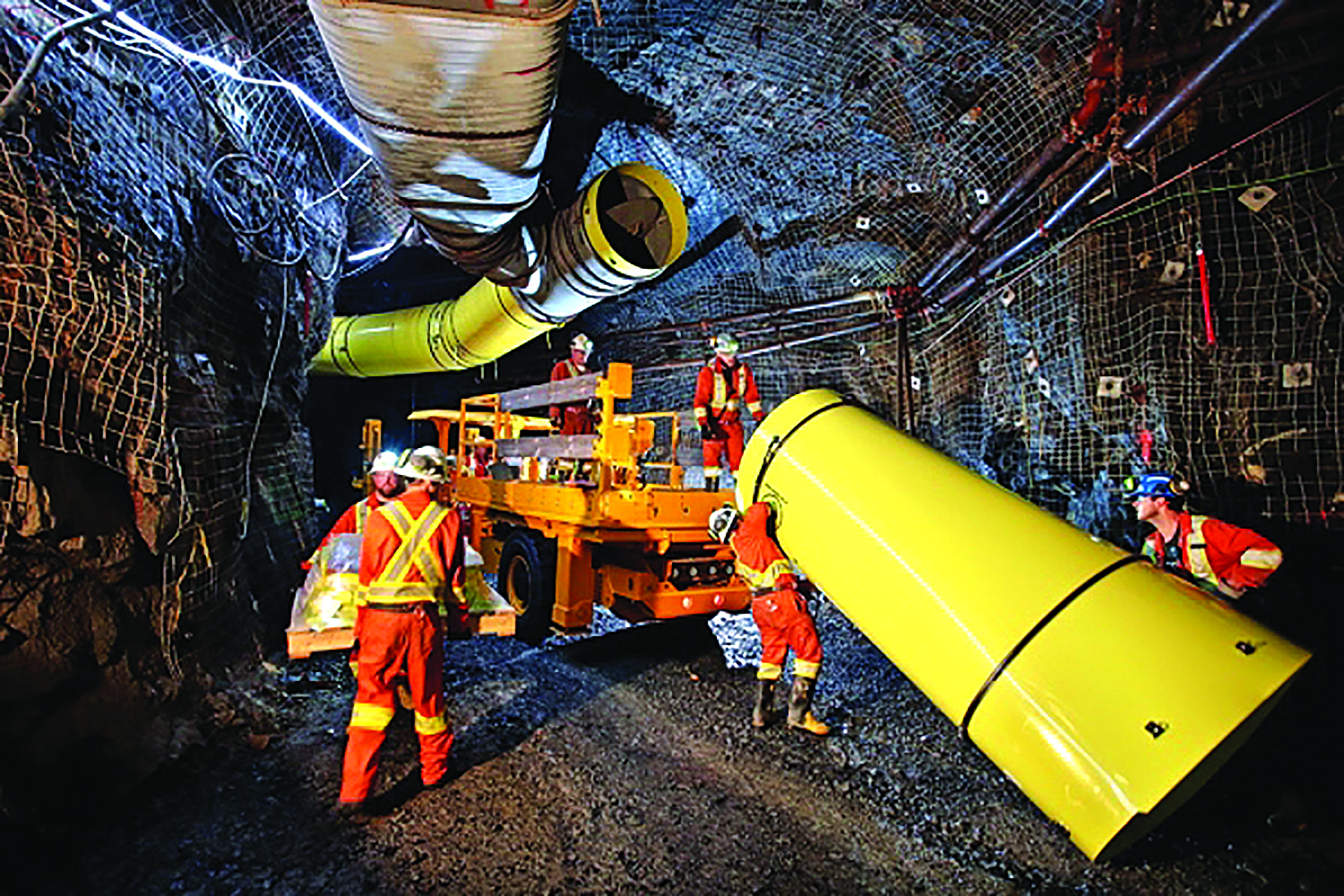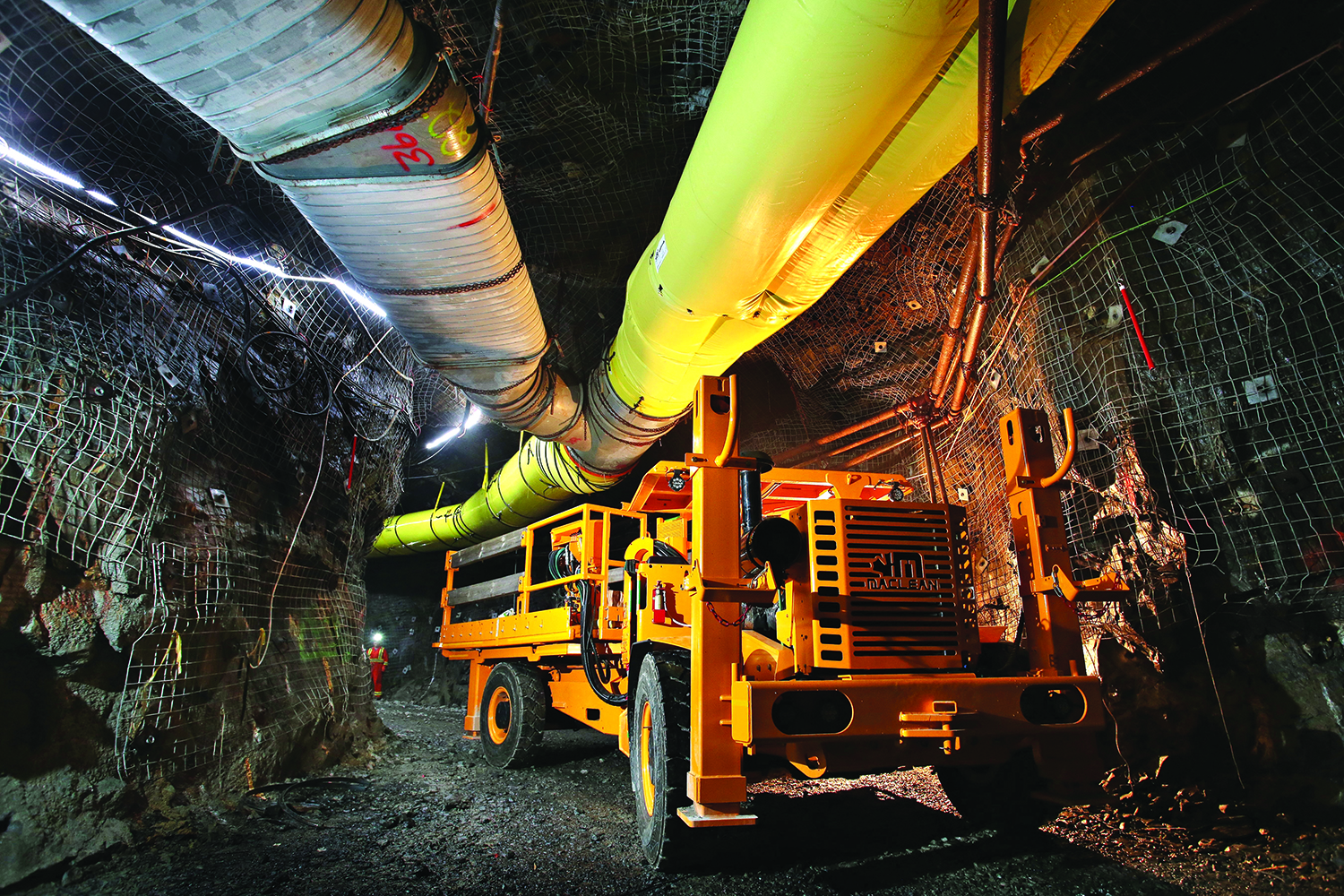
Keeping fresh air on the face improves working conditions and productivity. (Photo: Turnstone Industrial Solutions)
Idling production to improve mining conditions pays dividends
By Mike Walsh
The underground manager, my boss, who was simply known by his initials, AJ, was planning to be away from the mine for a few days, and he needed someone to manage the mine while he was gone. “Hey Mike,” he called to me “You’ve got a First Class ticket don’t you?”
“Yes. I just got it a few weeks ago,” I said.
“Great. I’ll be away for a few days so you can look after the mine for me while I’m away,” he said.
This might not be so significant in other countries, but it was critical in Western Australia. Mining was governed by the Mines Safety and Inspection Act which specifically said that a mine had to be under the control of a Certificated Underground Manager, and “An underground manager for a mine employing 25 or more persons underground … must be the holder of a First Class Mine Manager’s Certificate of Competency … . Penalty: In the case of a corporation $25,000 and in the case of an individual $5,000.”
Our site was a remote, Fly-In-Fly-Out operation so the manager could not just leave the site on a whim. It always took some planning and preparation, so it was enormously beneficial to have a back-up person on site who had a First Class ticket. And, I was that person.
We had about 50 to 60 people underground and they were producing about 8,000 ounces (oz) of gold per month so if an Underground Manager had no backup person who had a First Class Manager’s ticket, he simply could not leave without shutting the mine down. It was a major constraint. First Class ticket holders were valuable assets.
Before AJ departed he told me of the most important jobs, in addition to the projects that I was working on already and knew about.
“We are three quarters through the month and we are behind on gold production so you need to keep the pressure on,” AJ said. “We’ve produced about 5,000 oz so far but we should be up to about 6,000 oz by now. The most critical job is the 425 South drift. It’s long but it’s got the widest reef and the highest grades. It’s the one that’s keeping our noses above water right now. We need to keep that heading going.”
He left the mine at about 11 am to catch the 1 pm flight to Perth.
Ventilation Concerns
I had been heavily involved in the mine since the day we fired the first cut three years earlier, so I knew all the drifts and all the headings. I knew it better than anybody. I was also the statutory Ventilation Officer, appointed by the Department of Mines, and I knew the state of ventilation in every part of the mine too and I knew that the ventilation in the 425 South was poor. My responsibilities under the Mines Safety Act were to report any deficiencies to the Manager whose responsibility it was to fix them. And, I had told AJ about the 425 South a few times over the past three weeks. But he had not had it fixed.
The 425 South’s main problem was that it was about 180 meters (m) long and it was at the limit of the ventilation bag. It was narrow so we couldn’t fit a larger bag in. The 22-kW fan simply did not have enough power to push any more air along it. On top of that, the vent bag had been nicked and caught by the loaders and the jumbo going in and out, and it was full of little rips and tears. It was literally dying a death by a thousand cuts.
Now I had a different problem. Before that day I had completely fulfilled my duty under the law by making sure the Underground Manager, AJ, knew about the problems. It was his problem not mine, and if he ignored them, he was the one breaking the law, not me. But now, suddenly, he had left for a few days and I inherited the legal responsibility for all the problems that he had let slide.
The most critical of all problems was the 425 South. It was the worst ventilated heading in the mine and it contained more gold per meter than any other. We needed the 425 South so that we would meet our monthly production target, which was not just a number on a piece of paper — we needed revenue from gold sales to pay our workers and our bills.
I went underground with my anemometer and smoke tubes to look at the 425 S again, and it was a disaster. The 180 m of vent bag were in even worse shape than they were a week ago when I had last reported it to AJ. It had more new cuts in it, the old cuts had frayed and were even larger, and the bag was another 25 m longer. There were too many cuts in the bag to even count. It literally was a sieve and it leaked like one.
It was a very simple matter for me to measure its effectiveness. I stood by the fan and measured the total amount of air returning — it was about 30 cubic meters per second (m3/s). Then I walked to the far end of the bag, near the face, about a meter or two back from the end of the bag and measured the amount of air returning there. It was about 3 m3/s — not enough to blow out a candle. In other words, of the 30 m3/s that was being pumped into the bag by the fan, 27 m3/s were being lost through leaks and only 3 m3/s were getting to the face where they were needed.
The workers were divided — some cared about it, but others didn’t. But that didn’t matter to me, it wasn’t their problem. It was mine.
I checked with the shift-boss and he estimated it would take at least 12-18 hours to replace the bag and overall we would lose about 24 hours. It was worse than I thought. If we lost a full day out of the seven days that we had left in the month, we would lose any production gain that AJ had hoped we could catch up on.

Replacing the vent tubing didn’t take as long as expected and the lost production was quickly recovered. (Photo: Turnstone Industrial Solutions).
Making the Decision
The fact that we were operating the drift at a ventilation quantity below the minimum legal limit didn’t really bother me much, because I knew that the legal limit had a huge safety factor built into it, and our air quantity was still not harmful. The thing that worried me most was that the men working there were uncomfortably hot, and they knew the vent conditions were illegal. They knew that I was the mine’s Ventilation Officer, even though I was “Manager for a day or two” and they trusted me to look after them. I could not afford to let them down.
The contractor’s manager also wanted to keep the heading open. They were paid by the meter and he wanted 5 m advance every day to make his budget. But, at what cost?
I made my decision. The current situation was intolerable, and I could not justify it in any way. I called the shift-boss on the radio and ordered him to shut down the drift, pull all the old bag out and replace it with new. “Do not fix the old bag. Do not patch it. Pull it all out and put in new.” I said.
“But AJ said it’s our top priority heading,” he protested. “We need the production.”
“I know what our priorities are,” I said angrily into the radio. “And to h*** with the production. Fix the vent!”
“I’m not sure if we’ve got enough bag in stores,” he said.
“I know where there is more if you run out. Just get it done.” I said. I was willing to “take the heat” if we lost a day of production.
It was 4 pm, I had given the order, and now I left the crew to make it happen. I made up my mind to have nothing more to do with the process until I started back at work the next day. So, I went to the surface, focused on other important issues, finished the shift at 6 pm and went back to the camp.
I started at 6 am the next morning with the pre-shift meeting and my first question was “What is the status of the 425 South drift?”
“It went well,” the shift-boss told me. “We had plenty of new 750 mm vent bag in stores. We pulled out the old bag and had the new stuff installed by about 10. We got back operating by midnight.”
I thought to myself, “Hmm … only 8 hours delay. So much for all the drama and the exaggeration.” But I said cheerily “That’s great. You must have pulled out all stops to get it all up so fast.”
“Oh, it was nothing,” he said. “Our blokes are pretty good.”
Later I checked the production for that day to see how much we had lost in terms of gold production. There was no loss. In fact, we produced more that day than any day for the last week.
For the next week we achieved much faster daily progress in the 425 South, than we had for the past month. So, our total gold production was markedly up too.
The miners were pleased as well. The 425 S was a much nicer place to work than it had been for more than a month, so the men could work better and get more done. They all knew I had pushed to get the vent fixed and they all thanked me for it.
It was a valuable lesson for me as a young engineer. Do not cut corners, and do not sacrifice safety standards for production. The underground crew will appreciate improvements and when they know that you will make production sacrifices to ensure their safety they will all talk about it amongst themselves, and they will do their utmost to keep the mine running well.
Enforcing these sensible safety standards always pays off in the end.
Mike Walsh is a mining engineer, mine manager and mining consultant. He plans to share some of his experiences with a series of articles. He can be reached at: mike.walsh@1208.net.au.









